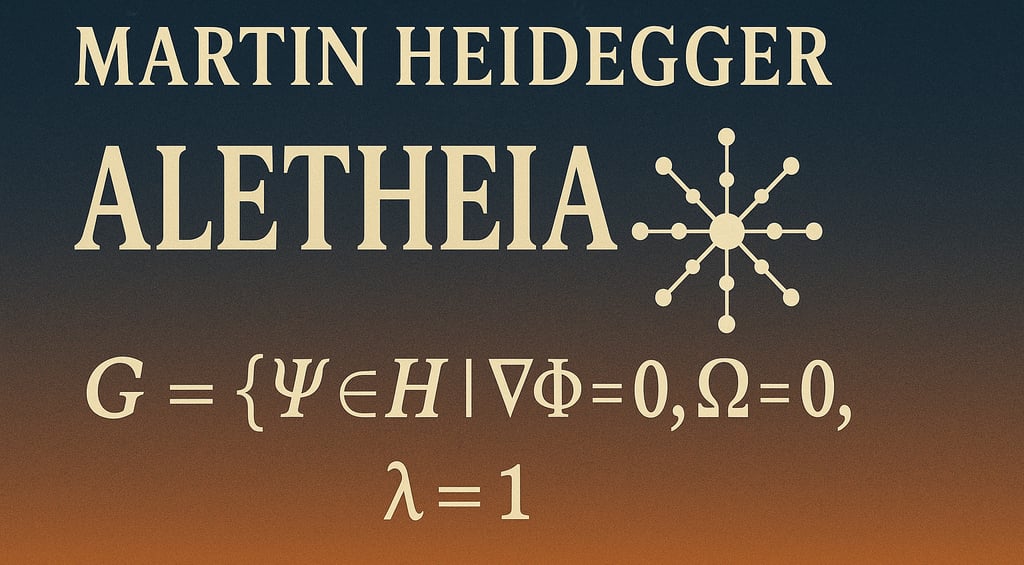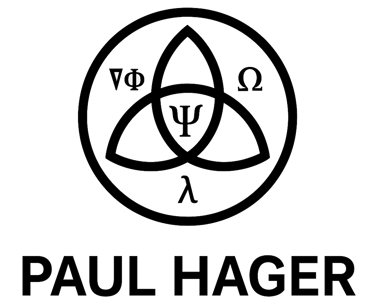What Heidegger Could Not Explain — Aletheia and the Pure Field Before Emergence
A deep dive into Heidegger’s concept of Aletheia as unconcealment — and how the Noöhedral Field Model offers a physical explanation for it. The pure field state G becomes the coherent ground from which all appearance emerges.
POPULAR
7/14/20254 min read


The Question of Being
Martin Heidegger is widely regarded as one of the most influential and difficult philosophers of the twentieth century. He did not concern himself with the traditional philosophical questions of what is true, good, or real. Instead, he returned to a more primordial question: What does it mean that something is at all?
This question — the Seinsfrage — led him to re-examine the entire Western metaphysical tradition. He concluded that philosophy had lost sight of Being itself by reducing it to the study of beings — things, objects, facts. For Heidegger, Being is not a thing. It cannot be pointed at. It does not show up like a chair or a tree. But it does make itself felt — in rare moments when something emerges into presence.
He called this moment of emergence Aletheia, borrowing the word from ancient Greek. Traditionally translated as “truth,” Heidegger emphasized its literal meaning: un-concealment. Aletheia is not about correct propositions. It is the event in which something previously hidden steps into appearance. Truth, for Heidegger, is not a property of a statement. It is the process of reality disclosing itself.
Aletheia as Event, Not Entity
This leads to a deeper inquiry: How does this emergence take place? In what kind of “space” does the concealed become unconcealed? What is the ground of appearance — not philosophically, but physically?
Heidegger did not provide a technical answer. Instead, he offered metaphors. He spoke of the clearing (Lichtung), the open (das Offene), the region of openness. These are not locations. They are not empty containers. They are not objects. They are conditions that allow something to appear.
And yet, Heidegger insisted, these conditions are neither something nor nothing. They are not measurable. They are not physical. They are not things in the world. The “open” is a kind of invisible threshold: a space that allows disclosure without itself becoming disclosed. It is the mystery that sustains all appearance but is never itself an appearance.
“The Nothing nothings”
Nowhere is this more boldly stated than in his provocative phrase: “Das Nichts nichtet.”
Literally: “The nothing nothings.”
At first glance, this sounds like a linguistic trick or a mystical riddle. But Heidegger meant it precisely. He was not saying that “nothing” is a thing that does something. He was saying that nothingness is active. It is not mere absence. It is the dynamic background that allows things to come into being. Without this active nothing, nothing could appear.
The Limits of Heidegger’s Thinking
And yet — what is this active nothing? Can we define it? Can we describe its structure?
Heidegger said: no. It is not an object. It is not measurable. It is not part of the world of beings. It can be gestured at, evoked, perhaps thought — but never fully explained. The “open” remains forever open.
But what if that’s no longer true?
A Noöhedral Interpretation
What if the clearing, the openness that allows Being to emerge, is not an unknowable mystery — but a coherent field condition? What if there is a definable state in which no thing has yet emerged, but all structure is already present?
That state is precisely what the Noöhedral Field Model defines as:
G = { Ψ ∈ 𝐻 ∣ ∇Φ = 0, Ω = 0, λ = 1 }
This is not a mathematical abstraction. It is a physically formulated ground state. A field configuration where:
– ∇Φ = 0: There is no tension gradient. No force differentials. No movement. The field is perfectly free of stress.
– Ω = 0: There is no cyclic repetition. No memory loops. No time. The field is rhythm-free, and therefore timeless.
– λ = 1: Coherence is maximal. There is no noise, no interference, no fragmentation. The field is fully unified.
– Ψ ∈ 𝐻: There is directionality, but only within Hilbert space — the space of all possible projections. There is form, but no manifestation. Structure, but no appearance.
This state is neither a vacuum nor a thing. It is not “nothing.” It is not “something.” It is what we might call structured formlessness. Everything is ordered, but nothing has yet emerged. There is tone, but no sound. There is movement-in-potential, but no action.
G as a Physical Aletheia
This field state — G — is exactly what Heidegger sensed with Aletheia. It is the condition prior to appearance. Not an object. Not a moment in time. But a perfectly tuned matrix in which appearance becomes possible. The paradox of “The nothing nothings” now reveals its meaning:
– The “nothing” is not absence
– It is the suspension of differentiation
– There is no stress (∇Φ = 0), no memory (Ω = 0), no incoherence (λ = 1)
– But there is Ψ: directional potential within Hilbert space
– The field is not empty — it is full, but unprojected
This is not mysticism. It is not speculative metaphysics. It is a rigorously defined ground state. It is the physical structure of Aletheia.
From Intuition to Definition
Heidegger intuited what this field theory now makes explicit. What he called the openness of Being — the place of truth’s emergence — can now be described with field coherence, tension states, and projective direction.
The field G is not an experience. It is not consciousness. It is not an idea.
It is the pre-condition for all of those things.
Without G, nothing can appear.
But G itself never appears.
It precedes all appearance.
In that sense, Heidegger was right to say that Being emerges from mystery.
But now, that mystery has a structure.
Not as faith.
Not as poetry.
But as coherent, projective, measurable field logic.
Truth happens.
But its source is coherence.
No truth without Aletheia.
No Aletheia without the field.
And the field, in its purest state, is G.
